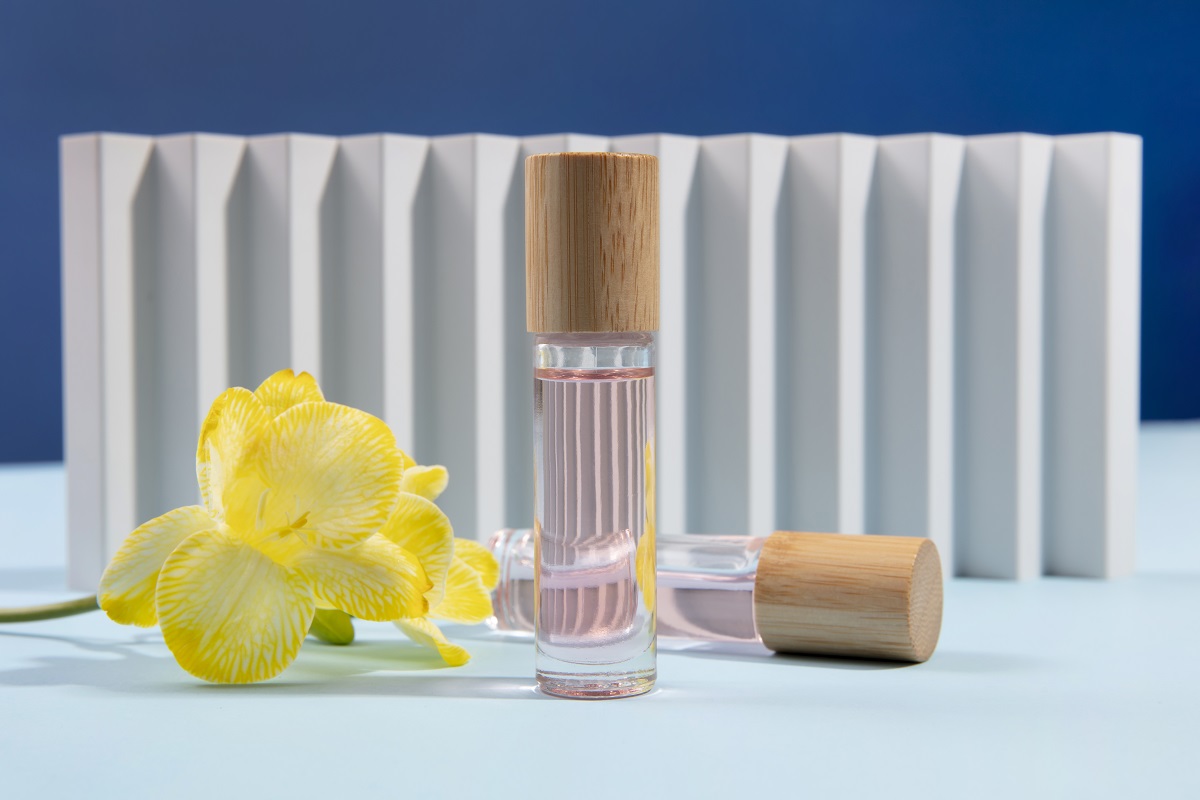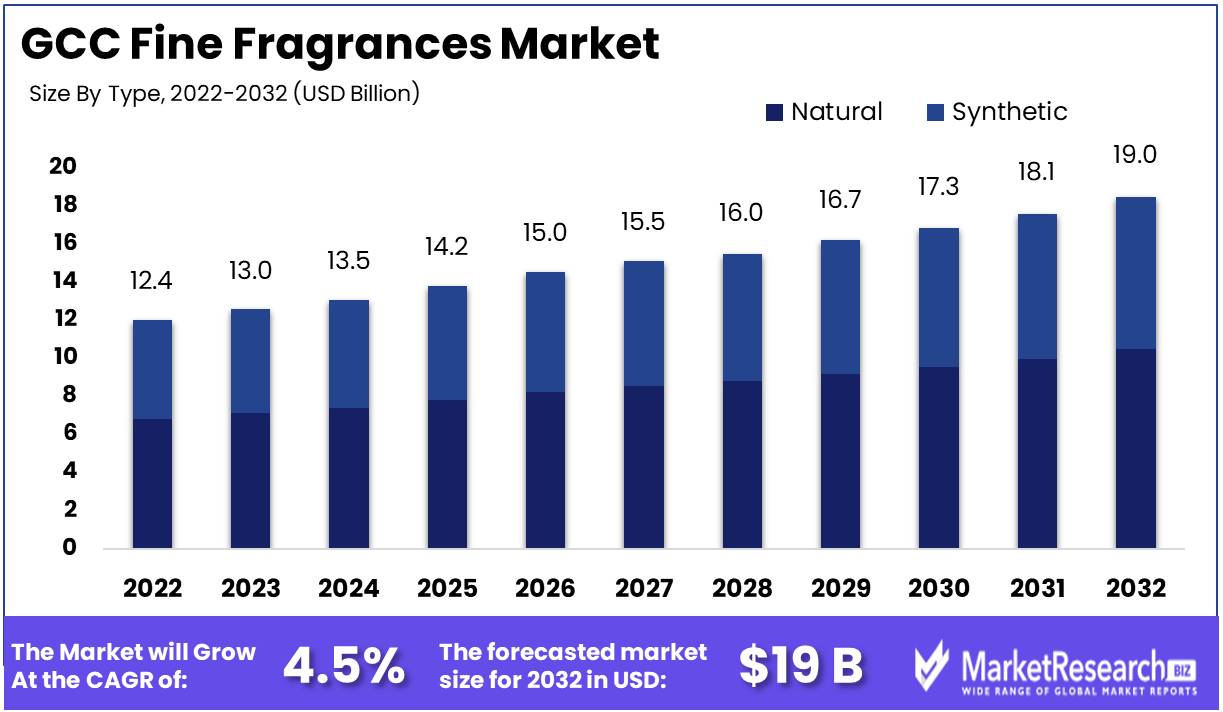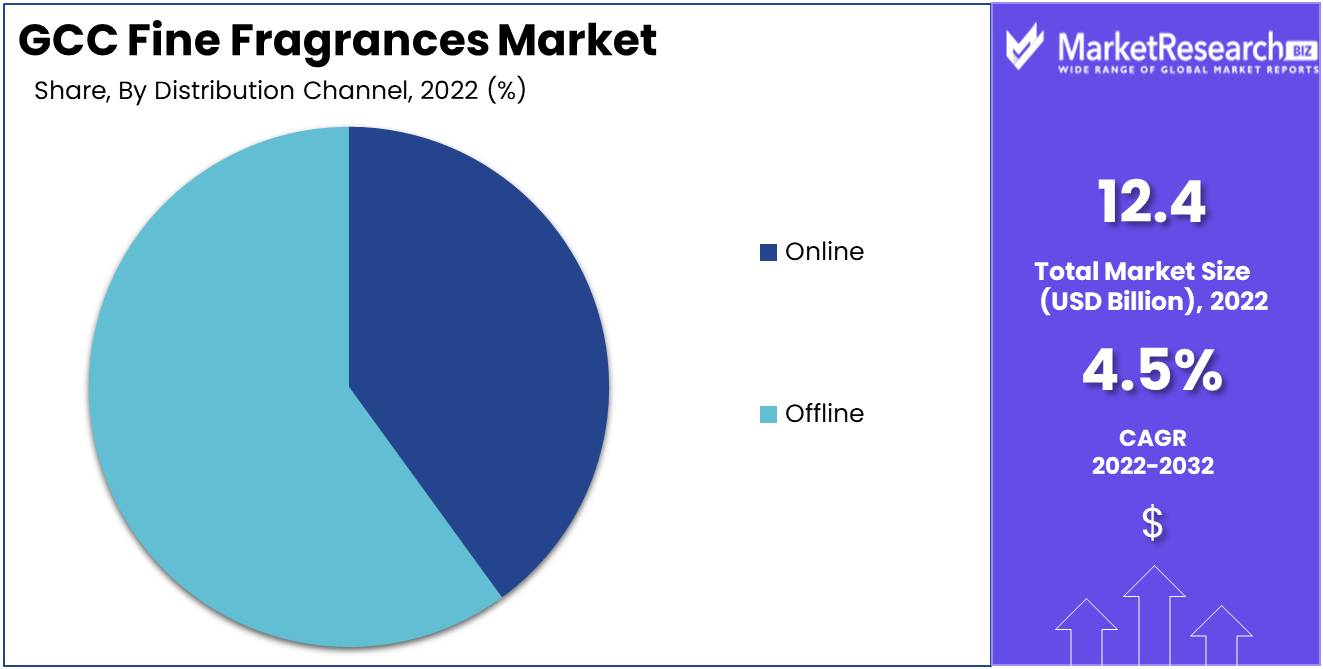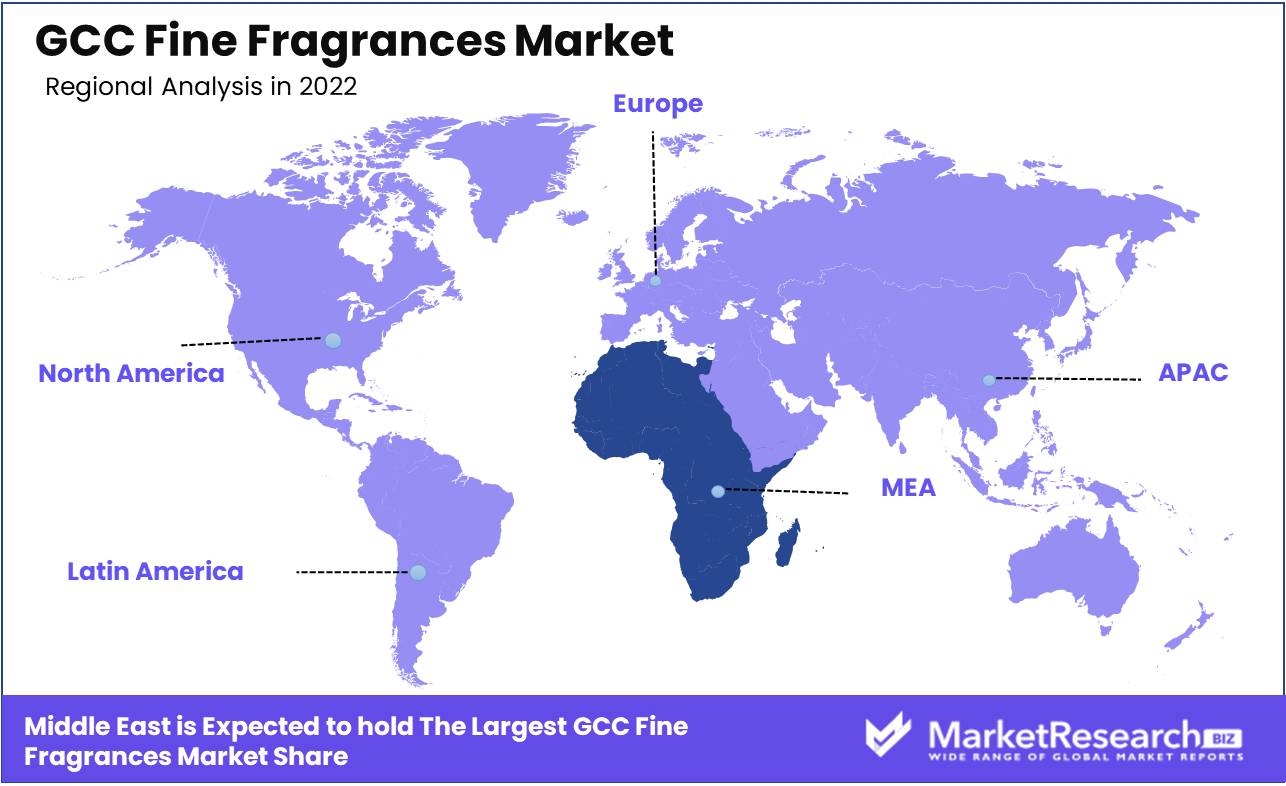
GCC Fine Fragrances Market By Type (Natural, Synthetic), By Form (Liquid, Gas), By Application (Perfumes, Spray, Deodorants, Personal Care), By Distribution Channel (Online, Offline), By Region And Companies - Industry Segment Outlook, Market Assessment, Competition Scenario, Trends, And Forecast 2023-2032
-
38340
-
June 2023
-
188
-
-
This report was compiled by Correspondence Linkedin | Detailed Market research Methodology Our methodology involves a mix of primary research, including interviews with leading mental health experts, and secondary research from reputable medical journals and databases. View Detailed Methodology Page
-
Quick Navigation
Report Overview
GCC Fine Fragrances Market size is expected to be worth around USD 19 Bn by 2032 from USD 12.4 Bn in 2022, growing at a CAGR of 4.5% during the forecast period from 2023 to 2032.
The Global GCC Fine Fragrances Market, a realm of opulent olfactory allure, manifests itself through the intricate orchestration of exquisite fragrances that captivate the discriminating sensibilities of cosmopolitan customers around the world. Respected companies strive to create olfactory works of art that transcend the mundane and embrace the transcendent within this splendid domain.

Luminaries of the Global GCC Fine Fragrances Market who are attuned to the symphony of progress have embraced technological miracles as drivers of progress. In their audacity, artificial intelligence algorithms pirouette upon the canvas of fragrance design, imbuing it with an unheard-of ethereal vitality. In addition, a harmonious alliance with nature has flourished as the industry enthusiastically adopts organic and natural ingredients, an alchemical synthesis that weaves an intricate tapestry of fragrant marvels.
But not only within the domains of creation does the Global GCC Fine Fragrances Market find inspiration; the pursuit of sustainability and responsibility is ingrained in its very essence. As companies undertake the sacred pilgrimage of forging responsible supply chains and manufacturing processes, the symphony of progress is accompanied by a chorus of responsibility. Conscious of their impact on the environment, these visionary entities endeavor to weave a tapestry of sustainability, advocating for the noble cause of a greener world where fragrance and ecology coexist in a harmonious embrace.
Diverse industries, with a shared vision of splendor, have turned their attention to the Global GCC Fine Fragrances Market, anxious to partake in its regal tapestry of aromatic allure. The personal care and beauty industry, luxury fashion and accessories conglomerates, purveyors of home and interiors opulence, and even automakers themselves, all seek to traverse uncharted olfactory realms where innovation and sustainability intertwine to create fragrant symphonies that defy expectations.
The mighty engines driving the Global GCC Fine Fragrances Market are propelled by the ceaseless tides of changing consumer preferences, which are the determinants of fate. Ethical and sustainable aspirations have taken flight like gentle zephyrs of change, guiding the discerning multitudes toward a future where opulence and responsibility are intertwined.
Driving Factors
Increasing Consumer Spending Power
The rising purchasing power of consumers in GCC nations is a significant factor in the expansion of the global GCC fine fragrances market. As individuals in these nations become more prosperous, their purchasing power for luxury and prestige fragrances increases. This has increased the market demand for exquisite fragrances.
Demand for luxury and premium fragrances is growing
The escalating demand for luxury and premium fragrances is another major factor driving the global GCC fine fragrances market. As consumers search for products of higher quality, they are willing to invest in fine fragrances with distinctive and exclusive scents. The desire for personal indulgence and the prestige associated with luxury fragrances have fueled this trend.
A cultural emphasis on Personal Hygiene and Fragrance
The GCC countries' cultural emphasis on personal hygiene and perfumery has played a crucial role in the market's expansion. Personal appearance and scent are highly prized in these cultures, resulting in a substantial demand for exquisite fragrances. As individuals endeavor to enhance their personal scent and make a favorable impression, the importance placed on grooming has created a lucrative market for premium fragrances.
Rise In International Tourism
The rise in international tourism has benefited the global GCC fine fragrances market. Tourists visiting GCC countries are exposed to a wide variety of fragrances, which frequently inspires a desire to purchase these products. The influx of tourists has contributed to the expansion of the market by increasing sales and broadening the consumer base.
Middle-Class Population Growth
The expanding middle class in GCC nations has had a significant impact on the expansion of the global GCC fine fragrances market. As more people enter the middle class, they acquire disposable income that can be spent on luxuries such as fine fragrances. The expanding middle class has become a significant consumer category, driving demand for premium fragrances and contributing to market expansion.
Restraining Factors
Cultural and Religious Considerations
In the GCC Fine Fragrance market, cultural and religious factors play a significant role in influencing fragrance preferences. The region's conservative Islamic culture restricts the use of perfumes, notably in prayer areas where alcohol-based fragrances are prohibited. In addition, cultural norms during events such as Ramadan, when the consumption of food, drink, and perfume is prohibited until after evening prayers, have a direct impact on fragrance sales and demand.
International Brands and Competition
The presence of international cosmetic and fragrance brands presents a formidable obstacle for the GCC Fine Fragrance market. These well-established brands have strong brand recognition and a substantial market share, making it difficult for local manufacturers to compete and keep up with the ever-changing demands of consumers. Local manufacturers must continuously innovate and adapt in order to maintain a foothold on the market in the face of intense competition from international labels.
The Volatility in Raw Material Prices
Due to the volatility of raw material costs, the GCC Fine Fragrance market faces difficulties. Since the region relies largely on imported raw materials for fragrance production, global factors such as currency exchange rates, political instability, pandemics, and climate change affect the prices of these materials. Local manufacturers struggle to maintain stable prices and desired profit margins, making it imperative for them to effectively manage the sourcing and costs of raw materials.
Economic Fluctuations
The Fine Fragrance market is significantly affected by economic fluctuations in the GCC region. The region's heavy reliance on oil and gas exports exposes it to fluctuations in global petroleum prices, which have an indirect impact on consumer purchasing power and fragrance demand. Additionally, international economic factors such as interest rates, inflation, and foreign exchange rates impact the purchasing power and spending patterns of regional consumers.
Type Analysis
The Global Gcc Fine Fragrances Market is segmented, with the Natural Segment being the most prominent. The Natural Segment contains fragrances comprised of natural constituents such as essential oils, plant extracts, and other organic substances. As consumers become more aware of the detrimental effects of synthetic chemicals in their daily lives, this market segment benefits from the rising demand for natural and organic products.
The adoption of the Natural Segment is propelled by the Economic Development in Emerging Economies. This segment's development in emerging markets, such as Asia-Pacific, Africa, and the Middle East, has been driven by an increase in disposable income and a shift in consumer preference for natural products. In addition, regulatory bodies are imposing stricter regulations on the use of synthetic materials in fragrances, resulting in a shift in demand towards natural fragrances.
Understanding the Consumer trend and behavior toward the Natural Segment is essential for forecasting the market's future growth rate. Consumers are becoming increasingly aware of the benefits of using natural products, and they are willing to pay a premium price for fragrances produced from natural ingredients of superior quality. In addition, newer generations are increasingly concerned with the environment and the ethical implications of using synthetic ingredients in fragrances.
Form Analysis
In the Global Gcc Fine Fragrances Market, the Gas Segment holds a dominant position. The Gas Segment contains fragrances containing synthetic constituents, whereas the non-volatile solvents are propane, butane, and others. The gas form of fragrance has a prolonged shelf life and is more convenient to use than other forms.
Economic Development in Emerging Economies drives the Gas Segment's adoption. Industrialization and urbanization in these nations generate demand for scents that complement their fast-paced lifestyles. Fragrance in gas form is portable and simple to use, making it a popular option among busy professionals and students.
Understanding the Consumer trend and behavior toward the Gas Segment is essential for forecasting the market's future growth rate. Increased incorporation of modern and Western lifestyles, coupled with the need for convenience, has contributed to the popularity of fragrance in gas form. However, consumers' awareness of the harmful effects of synthetic ingredients is increasing, and they may transition towards natural fragrances in the future.
Application Analysis
Global Gcc Fine Fragrances Market is dominated by the Perfumes Segment. The Perfumes Segment comprises fragrances used as a personal adornment to enhance an individual's overall aesthetic appeal. Compared to other varieties, perfumes contain a higher concentration of fragrance oils, resulting in a longer-lasting scent.
The Economic Development in Emerging Economies drives the Perfumes Segment's adoption. The growth of the middle class and the economy have increased disposable income, generating a demand for luxury products such as fragrances. This growth is anticipated to continue, generating demand for luxury perfumes.
Understanding the Consumer trend and behavior towards the Perfumes Segment is essential for forecasting the market's future growth rate. Consumers are increasingly fashion-conscious and willing to spend more on upscale fragrances to express their individuality and enhance their overall appeal. The rise of urbanization has resulted in an increase in workwear culture, in which fragrances are regarded as an essential accessory for projecting a professional and refined image.
A Distribution Channel Analysis
Global Gcc Fine Fragrances Market is dominated by Offline Segment. The Offline Segment consists of the distribution of fragrances through physical locations such as supermarkets, specialty stores, and independent fragrance stores. Because they can experience the fragrance and make informed decisions, consumers prefer purchasing fragrances from physical locations.
Economic Development in Emerging Economies is propelling the Offline Segment's adoption. Increases in per capita income and organized retail have created opportunities for brick-and-mortar retailers to meet the growing demand for fragrances. In emerging markets, the Offline Segment has a wider reach and is the preferred channel among consumers.
Understanding the Consumer trend and behavior toward the Offline Segment is essential for forecasting the market's future growth rate. Consumers prefer to smell fragrances before purchasing them, which is only possible when purchasing from physical locations. In addition, the traditional nature of the fragrance industry makes consumers hesitant to purchase fragrances online.

Key Market Segments
By Type
- Natural
- Synthetic
By Form
- Liquid
- Gas
By Application
- Perfumes
- Spray
- Deodorants
- Personal Care
By Distribution Channel
- Online
- Offline
Growth Opportunity
Unique and Region Specific Fragrance Blends
The development of one-of-a-kind and region-specific fragrance compositions is one of the most significant factors driving the growth of the GCC Fine Fragrances market. When it comes to fragrances, consumers in various regions have different preferences, and businesses that can cater to these preferences are likely to be more successful in the market. For instance, consumers in the GCC region prefer robust, long-lasting fragrances with oud, amber, and musk notes. Companies that can create fragrances with these characteristics will likely enjoy greater market success.
Customization and Personalization of Fragrances
The trend toward customization and individualization of fragrances is another factor driving the growth of the GCC Fine Fragrances market. Today's consumers are more concerned with their uniqueness and individuality, and they desire fragrances that reflect their personalities. Customers are likely to find greater market success with businesses that provide options for customization and individualization. They can allow consumers to select the fragrance's ingredients, notes, and intensity, allowing them to create a scent that reflects their individuality.
Expansion Into Neighboring Markets
The GCC Fine Fragrances market is not restricted to the GCC alone. There are a number of adjacent markets where businesses can expand their presence and increase their sales. The Middle East and North Africa (MENA) region, for instance, is a significant market for exquisite fragrances, with countries such as Egypt, Algeria, and Morocco offering significant growth opportunities. Companies that are able to expand into these markets and accommodate the preferences of local consumers will likely experience greater success.
Collaborations with Local Retailers and Influencers
Collaboration with local retailers and influencers is an additional tactic that can help companies realize the growth potential of the GCC Fine Fragrances market. These local retailers and influencers can assist businesses in comprehending the preferences of local consumers and provide valuable market insights. They can also aid in brand promotion and market visibility enhancement.
Latest Trends
The Rise of Niche and Artisanal Fragrance Brands
Globally, niche and artisanal fragrance brands are acquiring traction, and the GCC market is no exception. These brands offer distinctive and refined fragrances that cater to individual preferences and interests. In contrast to mainstream fragrance brands, which produce scents for mass-market distribution, niche and artisanal brands concentrate on producing high-quality fragrances with distinctive blends of natural ingredients. Due to the fragrances' superior quality and exclusivity, consumers are willing to pay a premium for them.
Integration of Oriental and Traditional Arabian Scents
The GCC region has a long history of fragrance production, and its perfumes are renowned for being distinctive and luxurious. Numerous mainstream and niche fragrance brands have adopted the trend of incorporating oriental and traditional Arabian aromas into their products. Middle Eastern and African constituents, such as oud, amber, and rose, are frequently used to formulate these fragrances.
Focus on Sustainable and Natural Fragrance Ingredients
The impact of chemicals and synthetic fragrances on human health and the environment is becoming increasingly apparent to consumers in the GCC region. As a result, there is a growing demand for eco-friendly, non-toxic, and ethically sourced fragrance constituents. Fragrance brands are responding to this demand by incorporating natural and sustainable ingredients and implementing eco-friendly manufacturing processes.
Utilization of Storytelling and Experiential Marketing
Increasing competition in the fragrance market has prompted a shift from traditional product-centric marketing strategies to narrative and experiential marketing. Fragrance brands are currently utilizing imaginative storytelling and experiential marketing to create emotional connections with consumers and distinguish their products from those of competitors. Pop-up exhibitions, scented installations, and fragrance workshops are a few examples of the distinct and immersive fragrance experiences that these strategies entail.
Regional Analysis
As a region with a long history of perfumery, the Middle East has dominated the GCC fine fragrances market. The region has long been associated with the production of high-quality fragrances and their use in various religious and cultural practices. Today, the Middle East's innovative, exotic, and opulent fragrances continue to captivate the market.
In recent years, the GCC fine fragrances market has expanded significantly in the majority of Middle Eastern nations. This impressive development can be attributed to a number of factors, including the rising purchasing power of the region's populace, which increases demand for luxury goods.
In addition, the Middle East fragrance industry has been prospering due to the availability of some of the highest quality natural ingredients in the world, such as oud and rose. These fragrances are renowned for their alluring aroma and their therapeutic and medicinal properties.
In addition, the region's rich cultural heritage has contributed to the development of the GCC's fine fragrances market. For instance, many traditional Middle Eastern fragrances, such as the exotic and seductive musk oud or the opulent and rare Taif rose, have become global symbols.
The growth of niche and artisanal perfumers in the region has also influenced the GCC fine fragrances market. These perfumers are renowned for blending traditional and contemporary fragrances that captivate the senses and elicit feelings of luxury, exclusivity, and sophistication.
In addition, the GCC is home to some of the world's most prestigious luxury brands that cater to the region's wealthy consumers. Due to the region's passion for premium and exotic fragrances, these international brands have chosen the Middle East as their primary market for luxury fragrances.

Key Regions and Countries
North America
- US
- Canada
- Mexico
Western Europe
- Germany
- France
- The UK
- Spain
- Italy
- Portugal
- Ireland
- Austria
- Switzerland
- Benelux
- Nordic
- Rest of Western Europe
Eastern Europe
- Russia
- Poland
- The Czech Republic
- Greece
- Rest of Eastern Europe
APAC
- China
- Japan
- South Korea
- India
- Australia & New Zealand
- Indonesia
- Malaysia
- Philippines
- Singapore
- Thailand
- Vietnam
- Rest of APAC
Latin America
- Brazil
- Colombia
- Chile
- Argentina
- Costa Rica
- Rest of Latin America
Middle East & Africa
- Algeria
- Egypt
- Israel
- Kuwait
- Nigeria
- Saudi Arabia
- South Africa
- Turkey
- United Arab Emirates
- Rest of MEA
Key Players Analysis
Procter & Gamble is the market champion, with a roughly 25% market share. In the Arabian Peninsula, where they have a variety of brands including Arabian Oud and Scents of Arabia, they are especially dominant.
On the other hand, L'Oreal is renowned for its high-end luxury labels, such as Lancome and Yves Saint Laurent. Estee Lauder, another major participant, has a robust portfolio of brands that includes Jo Malone, Michael Kors, and Tom Ford, whereas Coty is well-known for its celebrity-endorsed fragrances, which include those of Katy Perry and David Beckham.
All of these key actors have recognized the growing demand for natural and organic fragrances and have begun to develop products to meet this demand, providing consumers with a healthier and more environmentally friendly alternative. This shift in consumer demand, in conjunction with the increasing influence and purchasing power of millennials, is propelling the trend toward more ethical and environmentally friendly fragrances.
Top Key Players in Gcc Fine Fragrances Market
- Procter & Gamble
- L'Oreal
- Taskagao International Corporation
- Gulf Flavours & Fragrances
- Zohoor Alreef
- CPL Aromas
- TAC PERFUMES
- Yas Perfumes
- Kering Hollanad NV
- Parfex
- Firmenich SA
- Other Key Players
Recent Development
- In 2022, the renowned Saudi Arabian perfumery Arabian Oud launched its first flagship store in the United States. The new store in New York City provides customers with an extensive selection of high-quality Middle Eastern-inspired fragrances.
- In 2023, Ajmal Perfumes, a well-known fragrances brand based in the United Arab Emirates, also made a significant announcement with the introduction of a new fragrance line called Ajmal Paris. The new line combines French and Middle Eastern fragrances in a way that highlights the rich cultural heritage of both regions.
- In 2023, Al Rehab Perfumes increased its retail presence in the United States, in addition to these thrilling developments. Al Rehab Perfumes has become a popular choice among customers in the United States and around the world due to its extensive selection of affordable and long-lasting fragrances of high quality.
Report Scope
Report Features Description Market Value (2022) USD 12.4 Bn Forecast Revenue (2032) USD 19 Bn CAGR (2023-2032) 4.5% Base Year for Estimation 2022 Historic Period 2016-2022 Forecast Period 2023-2032 Report Coverage Revenue Forecast, Market Dynamics, COVID-19 Impact, Competitive Landscape, Recent Developments Segments Covered By Type (Natural, Synthetic)
By Form (Liquid, Gas)
By Application (Perfumes, Spray, Deodorants, Personal Care)
By Distribution Channel (Online, Offline)Regional Analysis North America – The US, Canada, & Mexico; Western Europe – Germany, France, The UK, Spain, Italy, Portugal, Ireland, Austria, Switzerland, Benelux, Nordic, & Rest of Western Europe; Eastern Europe – Russia, Poland, The Czech Republic, Greece, & Rest of Eastern Europe; APAC – China, Japan, South Korea, India, Australia & New Zealand, Indonesia, Malaysia, Philippines, Singapore, Thailand, Vietnam, & Rest of APAC; Latin America – Brazil, Colombia, Chile, Argentina, Costa Rica, & Rest of Latin America; Middle East & Africa – Algeria, Egypt, Israel, Kuwait, Nigeria, Saudi Arabia, South Africa, Turkey, United Arab Emirates, & Rest of MEA Competitive Landscape Procter & Gamble, L'Oreal, Taskagao International Corporation, Gulf Flavours & Fragrances, Zohoor Alreef, CPL Aromas, TAC PERFUMES, Yas Perfumes, Kering Hollanad NV, Parfex, Firmenich SA Customization Scope Customization for segments, region/country-level will be provided. Moreover, additional customization can be done based on the requirements. Purchase Options We have three licenses to opt for: Single User License, Multi-User License (Up to 5 Users), Corporate Use License (Unlimited User and Printable PDF) -
-
- Procter & Gamble
- L'Oreal
- Taskagao International Corporation
- Gulf Flavours & Fragrances
- Zohoor Alreef
- CPL Aromas
- TAC PERFUMES
- Yas Perfumes
- Kering Hollanad NV
- Parfex
- Firmenich SA
- Other Key Players




